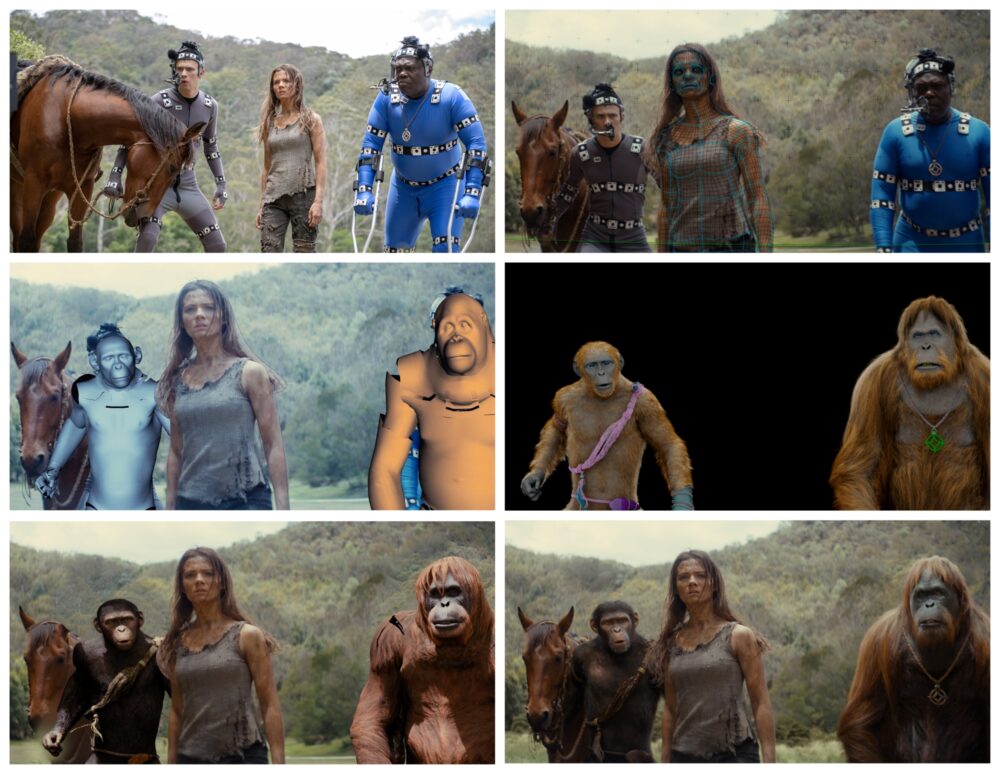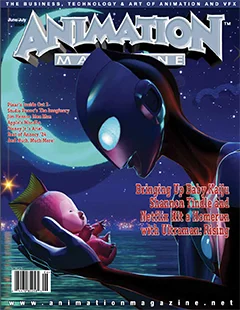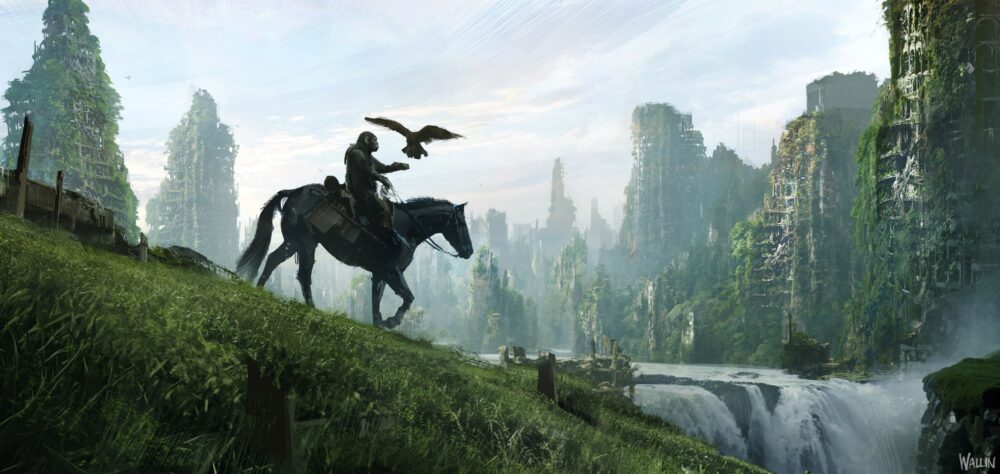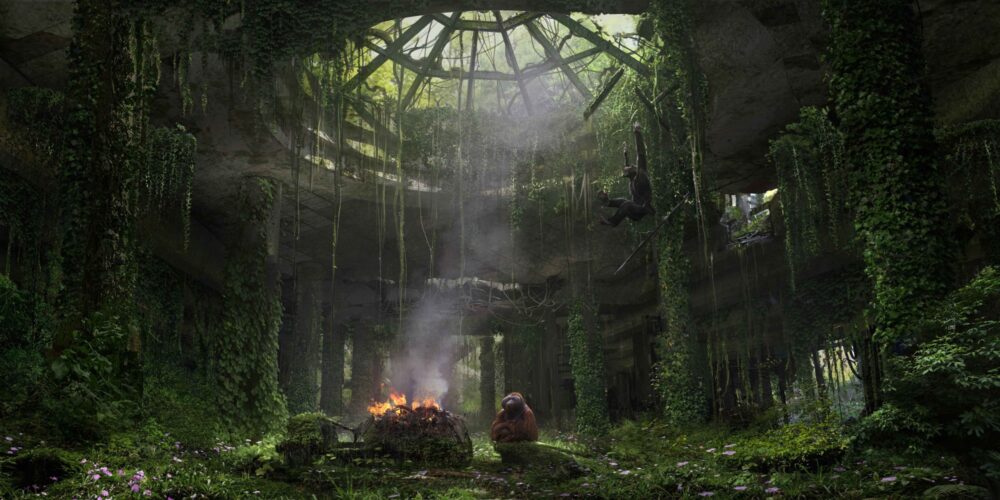|
Getting your Trinity Audio player ready...
|
Wes Ball is a high-profile example of a visual effects artist who has successfully forged a career as a big studio director. After bringing James Dashner’s The Maze Runner series to the big screen, he shifted his focus to launch a new trilogy with Kingdom of the Planet of the Apes. Unlike previous installments of the durable franchise, the late spring release is more about refining rather revolutionizing technology.
“It’s more to do with what we can [do] but even better with fewer resources and less time in a way,” Ball tells Animation Magazine. “A big fun part of this take is the apes are entering the Bronze Age; they’re designing things, have cultures and societies and are mimicking our own journey as a species through civilization. The design and immersion into this other world and culture has been a lot of fun.”
Ball has established a global network of concept artists, some of whom he has never met in person. “There are whole ideas in the script that weren’t even in the script until we actually came upon them visually, and then they get inserted into the script in a cool way. For me, that is a huge part of the process, which ultimately is what cinema is to me. Sound is 50% of the experience, but the stories behind that image are crucial.”
Concept Art Is King
The director says that he had a book of all the concept art that would come in weekly for the entire team. “I would arrange it in story order, and it has the breakdown for all of the character designs,” says Ball. “That’s the most concept art I’ve ever done in my life, with the exception of [abandoned project] Mouse Guard, where everything was designed, explored and looked after. It’s an incredible luxury to be able to do that.”
Unlike the Statue of Liberty twist in the original, iconic landmarks are not central to this movie’s narrative. “We never say or show it, but we based it on Southern California,” he says. “A lot of the landmarks that you do see are there, but they’re not like pull you out, ‘Oh, that’s such and such!’ That’s an important part of the movie because our character Noa is exploring this world for the first time.”
‘A big fun part of this take is the apes are entering the Bronze Age; they’re designing things, have cultures and societies and are mimicking our own journey as a species through civilization.’
— Director Wes Ball
Although the principal cast comprised mostly digital characters, except for the two main humans portrayed by Freya Allan and William H. Macy, the filmmaking methodology was based on live action rather than animation. “We tried to do everything in camera that was within my scale of build and budget,” explains the film’s production designer, Daniel Dorrance. “Also, when you’re working in motion capture, the actors need anything they can to grab onto to make this whole thing feel real.”
The film’s pivotal locations also had to go through a complete rethink. “We were going to New Zealand up until the last week, but then suddenly had to change plans and went to Australia instead. We were looking for a lot of ruined locations to give us a little help on the ground. We found these old coal factories and power plants that Australia has now defuncted, and they were perfect. But we didn’t use them as a power plant but as something to paint on, essentially. It’s always helpful to have a structure or shadow for visual effects to paint out because that gives it more reality. Once we had a location, now we were able to adapt for the story, action beat and what suits those scenes the best for what we’re given.”

Actress Freya Allan, who portrays the character Mae in the movie, was tasked with acting against invisible players and having to pretend she was being pulled in order to get clean plates for her CG counterparts to be inserted. “I’ve been in projects that have involved a lot of these big visual effects moments,” says Allan. “But I must say that [with] this job, the only thing that I was having to do in regards to that was when the actors would be taken out and I would have to do the whole scene without them there. That was the hardest part, where I would be staring at nothing. But the majority of the time beyond that, we were in these most amazing locations in the middle of nowhere that did so much of the work for us. I was relieved with that. We weren’t boxed into a studio.”
Allan she was keen to do her own stunts. “It’s my project and person, and I want to be able to do every part of that. I also love stunts. I find it [as] an added bonus to the job. I find stunts to be a fun challenge and I always like to be challenged. The adrenaline of it on the day and getting it right on the day; I find the whole process exciting.”

As with the Planet of the Apes prequel trilogy and The Maze Runner franchise, Wētā FX was in charge of creating 1,500 visual effects shots.
“I’ve made four movies with them [Wētā FX], and it’s incredibly humbling to work with the best in the world at what they do,” says Ball. Erik Winquist, the film’s VFX supervisor, was one of the first people the director met with at the beginning of the project. “Erik knows what he’s doing and is also a filmmaker and storyteller, not just a technical guy, which is important. Erik is thinking about emotion and what’s important for the shot; he is a real partner, especially for this movie.”
“This isn’t a magic box where you inject facial capture into and out comes an ape,” notes Winquist. “The actor gives us the soul or blueprint of the character. But it’s the animator who needs to then figure out what that means in the context of an ape’s face, because if we literally did a 1:1 mapping where they were doing exactly the same thing, it’s eerie, uncanny and doesn’t convey the same emotion.”
Facing Design Choices
“As we’re building the characters from a design standpoint, we’re also getting in and doing early testing on the rigs,” adds Winquist. “What sorts of facial shapes and where do we need to make adjustments to those facial shapes? Because of the way that the crease lines are coming from the nasolabial fold when they make a smile maybe isn’t conveying the same sort of thing, so we go in and make adjustments to those shapes as we go.”
The film’s environmental work involved CG work on the eye-popping environments. “The beauty of it is that Australia provided a plentiful amount of greenery in the locations that we were shooting in,” says Winquist. “So, our job then became tying into and matching that. We had so much fantastic reference[s] from the plate photography and all the reference material that we gathered there, which was fed into our existing plant tool set called Lumberjack. Avatar: The Way of Water drew on that a lot as well. The quantity of vegetation was certainly daunting. Earlier in the film, audiences will see some landscapes that couldn’t possibly exist which are heavily covered in vegetation. Make sure to keep an eye on those!”
The film has no shortage of scenes that seamlessly incorporate digital effects. “The water has been among the biggest things that we have had to wrestle with in the movie in terms of making sure that it looks absolutely believable, and the shots are breathtaking,” says Winquist. Allan also points out that the film’s water scenes are quite impressive. “There are some major achievements in terms of water visual effects, for sure,” she notes. “Being the actor, I’m excited for people to get to really enjoy the emotional journey that the characters go through. The Planet of the Apes franchise has a depth to the stories, which I feel our film maintains and I hope that is appreciated.”
20th Century Studios’ Kingdom of the Planet of the Apes is currently playing in theaters around the world.








 Win a Funko X Lilo & Stitch Prize Pack!
Win a Funko X Lilo & Stitch Prize Pack! 
